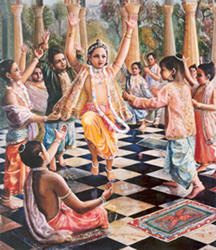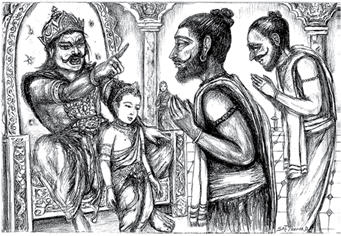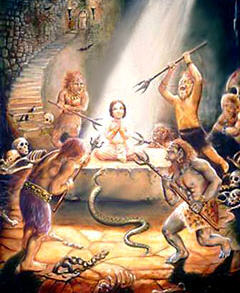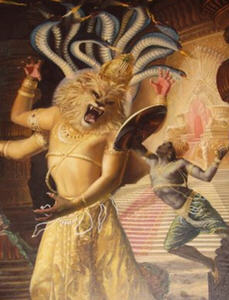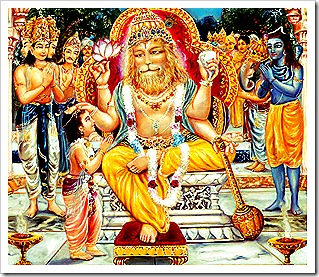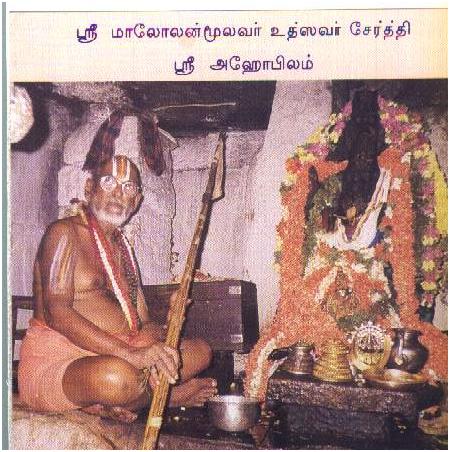
The Sthalapurana of Ahobilam gives an account of nine forms of Narasimha worshipped here. In short, the Sthalapurana of the temple, which is said to be Brahmanda Puranatargata (part of Brahmanda Purana) with ten chapters, described the greatness of Kshetra in the first chapter. The second chapter of the Purana narrates the performance of the penance of Garuda for the darshana of the Lord. The third chapter gives an account of the sacred ponds of the place. The fourth chapter furnishes an account of the nine temples of Narasimha in his nine forms and performances of the penances by Bramha, Bharadvaja, Gobhila and Bhargava Rama. The fifth chapter relates the traditional story of Jaya and Vijaya and their birth as Hiranyaksha and Hiranyakasipu respectively and the assurance given by the Lord to the gods for their protection. The sixth chapter describes, at length, the child hood of Prahlada and the atrocities perpetrated against him by his father. The seventh chapter narrates the devotion of Prahlada of the Lord, birth of Lord Narasimha and the destruction of the demon, Hiranyaksha .The eighth chapter mentions the Sarabhavatara and his destruction by Lord Narasimha. The ninth chapter states explicitly the untiring efforts of Bhairava for the river Bhavanasini and his becoming Kshetrapala of the place. The last chapter clearly states that worship to the deity of the Lord is the only means for attaining salvation to the common people.
Brahma, Lord Sri Ram and Lord Srinivasa, the most popular deity of Tirumala, Tirupathi also worshipped Lord Narasimha. The Lord of Ahobila Narasimha is referred to as “Peria Perumal” (God of gods) in Sri Vaishnava tradition. It is stated that when Sri Rama was in the forest, we know from Seshadharma that he prayed to the Lord of Sri Ahobila with Panchamrta Stotra. In Archavatara, Lord Srinivasa had married Padmavati, only after offering worship to Sri Narasimha of this mountain.
Traditional accounts depicted in Ahobilam Kaifiyat:
In the days of yore when truth and dharma prevailed, great heat was observed near the mountain cave of Ahobila. According to legend when grass was put in the cave, it caught fire and smoke emitted. Several great rishis lived here for a time. After sometime, with the knowledge that these great places would become common visiting place in the Kali age, they left for the northern lands, covering up the Narasimha cave with boulders. Traditionally, therefore this place is being called as Narasimha Kshetra.
Ahobila kaifiyat also mentions about King Prataprudra of Kakatiya dynasty becoming a devotee of Lord Narasimha. Pratap maharaj was an ardent Shiva bhakta. Every morning before beginning his duties, he would first have a golden Shiva lingam cast, then he would worship the linga and later gift the lingam in charity. This daily puja of his was never altered. Once he went hunting near the Ahobala forest accompanied by his ministers, priests etc. As he was getting ready for his Shiva aradhana, it was brought to his notice that however hard the goldsmith tried his best to cast a Shiva Lingam, the lingam was forming itself into Narasimha form. Everyone present was mystified. Without his Shiva aradhana and without taking any food, the king went to sleep that day. In his dream, Lord Narasimha appeared and dictated the king to renovate the temple at Ahobalam. Lord also directed the king to contact a boy Srinivasa and ask him to come to Ahobilam to establish the daily puja, rituals etc. The king immediately arranged for the temple renovation. When word was sent to Srinivasacharya, son of Kidambi keshavacharya of Melkotte, he came to Ahobilam. Young Srinivas was an erudite vaishnava scholar and had previously upheld the merits of Sri Ramanauja’s teachings in the court of King Krishnadevaraya of Vijayanagar. When Srinivasa reached Ahobilam, the king handed him over the golden cast of Lord Narasimha to worship hence forth. The king Prataprudra also became a vaishnava. Later Lord Narasimha personally appeared as a yogi and gave sannyasa to Srinivasa and he became to be known as Satagopa yati. He became the founder of Ahobilam Matha and it is his successors who are now the Jeeyars of Ahobilam math. The Golden Deity of Narasimha given to Srinivasa (Satagopa yati) is still in possession of Ahobilam matha jeeyars. It is said that during the festivals, this Deity is carried up the hill to upper Ahobilam and then return back to lower ahobilam. Invariably whenever Lord is carried from upper ahobilam back down, it is said that heavy rainfall occurs (even today).
An inspiring story of 33rd jeeyar of ahobilam matha:
One day the jeeyar was going through dense forest accompanied by his disciples, journeying from Ahobilam to Mysore. On the way, the Jeeyar decided to halt at a spot near a small rivulet to perform his evening puja to his Lord. As he was settling down to offer prayers, there was a commotion and his disciples rushed to him saying that dacoits had come to loot their property. The unperturbed Jeeyar went to meet the leader of the dacoit gang and told him that they had nothing which belonged to them. Everything they possessed belonged to God and requested him to take it after he finished his puja to God. The leader agreed. The jeeyar commenced his puja. He offered “Chakkarai Pongal Sweet prepared out of rice and jaggery” to the Lord. He did Mangala arati to the deity 3 times and at the end of third round, all dacoits suddenly fell at the feet of Jeeyar and asked him to protect them saying that a large number of lions were attacking them. The Jeeyar could not see the lions but he realized that his Lord had come to rescue him. He requested the lions to disappear. The dacoits who had come to rob fell at his feet begging forgiveness and then escorted the jeeyar safely out of the forest.
Chenchu Parinaya in folklore:
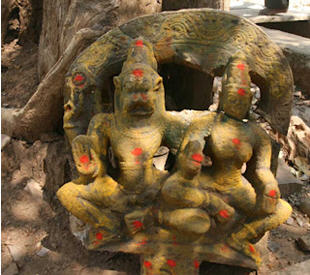
There are a number of popular legends of Narasimha, which are widely popular among the Chenchus, who are closely associated with Ahobilam. The popular legend is that “When Lord Vishnu incarnated as Narasimha, the Golden Lakshmi was born in the Chenchu tribe and both were living very happily. On account of this, the Lord is said to have refused to go back to Vaikuntam. The love making of Lord Narasimha with Chenchita, a tribal woman is famous in many folk songs of the place. The sculptures of Narasimha and Chenchita on the pillars of the temple of upper and lower Ahobilam and Vasantika Parinayam, a Sanskrit drama, written by Jiyar, the seventh pontiff of Ahobila math, describing the marriage of Lord Narasimha with Chenchita , lend support to the popular legend. There are several folk songs on the lips of many people of this region. These folk songs are more imaginative than historical and add various episodes to the story of Chenchita. They depict the love episode between Lord Narasmiha and Chenchita.
Sometime during the 14th century:
The Vijayanagara empire was declining in importance but by the grace of the Lord of Ahobilam, the kingdom was resurrected through Saluva Narasimha.
Long ago King Saluva Mangu restored the deity of the temple of Srirangam, had a son called Gautha who was then ruling Chandragiri. Gautha’s son called Gunda had a wife called Mallambika. They didn’t have any children for a long time. To get their desires fulfilled they had observed a number of vows and finally retired to Ahobilam for performing penance. Pleased with their penance, Lord Narasimha appeared to the king in a dream and blessed him with a son possessing of all the virtues and ordained that he should rule the empire. The king, later, narrated this to his wife. The king was blessed with a son whom they named Narasimha after the god of Ahobilam. In due course, Saluva Narasimha proved to be a very good king of the Vijayanagara Empire and protected the Vedic culture.
In the year 1579 A.D, the forces of Ibrahim Ali Kutub Shah, the Sultan of Golconda, attacked Ahobilam. They completely demolished the temple structures , plundered the jewel-studded deities of Lord Lakshmi Narasimha and carried them to Golconda. The deities were brought into presence of the sultan by one MurahariRao. When the deity of Narasimha which was made of gold and silver and studded with precious rubies was shown to him along with the other treasures looted at Ahobilam, the Sultan was perplexed and stunned. stunned. He could not speak since then and the night, he vomited blood and died. According to some, the exact circumstances in which Ibrahim Kutub Shah, second in succession to KuliKutu Shah died remained mysterious. However After with this event, the attitude of the subsequent rulers of Golkonda underwent a remarkable change towards the Hindus, the Hindu temples and the Hindu culture.
Vedaachal and Garudaadri :
Some other account also adds up to the reason for these names. Many of the mountain peaks here have shape of Garuda, so the name Garudadri. Also Garuda did his penance to see Lord’s form as mentioned before. Regarding Vedachal, another version mentions that once a demon Somaka stole Vedas from Brahma. Lord Brahma came here and prayed. Lord then killed Somaka and restored Vedas back to Brahma on this hill.
Adi Sankaracharya and his disciple Sunanda:
Once when Adi Sankara along with his disciples was going to Ahobalam, he came across a hunter. The hunter told the acharya that for a long time he had been doing “Bhairava aradhana” and he had to offer either a king or a sannyasi as a sacrifice for completing his puja so that his prayers are answered. The sannyasi Adi sankara decided to allow his body to be sacrificed by hunter. He told the hunter to choose a time when his disciples won’t be around him and he can then behead him and offer him as sacrifice. The hunter was very pleased at the proposal. Hunter waited for the opportunity. One of very closed disciples of Adi sankaracharya, Sunanda came to know about this. So he intensely prayed to his Deity Lord Narasimha of Ahobalam to spare the life of his guru. Lord Narasimha personally manifested himself and killed the hunter and rescued Adi Sankaracharya. The place where Adi sankara was doing his penance and where the hunter was killed came to be known as Bhairava Kunda.
Sunanda was born in Ahobilam and was a devotee of Lord from his birth. He was originally of name Vishnu Sharma. His father was a great pandit named Madhavacharya and mother was Lakshmi devi. When both parents had no children for a long time, they prayed to Lord at Ahobalam.In answer to their prayers, this child was born. As he grew up, his parents died and he gave up all his wealth and property to Lord at Ahobalam. He stayed at the temple offering his services fulltime. Once Lord appeared in his dream and told him to take his bath in Bhavanashini river. A old brahmin would appear to Sunanda and would give him a precious stone. This stone would make anyone invisible when it is kept inside one’s mouth. In that invisible form, he was then advised to go to Kashi (Varanasi) and see Adi Sankaracharya. He was told that at that time there would be a debate going on between Adi Sankara and an old Brahmin for about 8 days. He was advised to inform Adi sankara that the old Brahmin he was debating was Srila Vyasadeva. The Lord also told him that after this good deed done by him, Adi Sankaracharya would accept him as his favorite disciple. The next day, things happened as predicted and Sunanda became acharya’s favorite disciple. This caused heartburn amongst the other disciples who wondered how a disciple who came later than them could become the Acharya’s favorite disciple. Coming to know of this, Adi Sankara decided to teach all other disciples a lesson. One day acharya went to other banks of Ganga to take bath and from there he called out to Sunanda to come to him. Even though he was on opposite sides of Ganga, Sunanda decided to answer the call of his guru. He thought that Guru is representative of Lord and that if he put full faith, he could cross the river easily. With faith on Lord and his Guru, he entered the river. A miracle occurred. He was able to walk across the river and wherever his feet touched the water, a lotus would come under the feet. Thus he crossed the river stepping on various lotuses all the time repeating the names of Ahobalam Narasimha and meditating on the feet of his Guru (Paad Padma). Other disciples who saw the miracle then realized the greatness of Sunanda. From that day on, Sunanda came to be known as Padma Paad.
Laxmidevi as Chenchu laxmi:
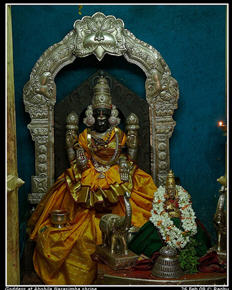
Once upon a time Samudra raja (ocean god) was cursed to be born in a tribe of name Chenchu. Sri Mahalaxmi manifested herself as his daughter known as Chenchu laxmi. Being aware of this, Lord came down adorning role as a Chenchu. Samudra raja was not aware of this and felt that his aristocratic daughter had fallen in love with an ordinary chenchu man. He decided to kill him. At that time, Lord Narahari appeared and told him the truth. The Lord’s marriage with Chenchu laxmi was celebrated and Samudra raja also got released from his curse. Because Lord married a lady belonging to chenchu tribe the Lord became their son in law. Even today during the utsavas, the chenchu tribes bring honey, sandal paste, clothes and other forest products and offer them to Lord, who is their son in law. They affectionately call him “Obulaesudu” (short version of Ahobalesudu Lord of Ahobalam). A sanskrit drama “Vasantika Parinaya” written by the seventh Jeeyar of the Ahobala matha describes the marriage of the Lord with Chenchu laxmi.





